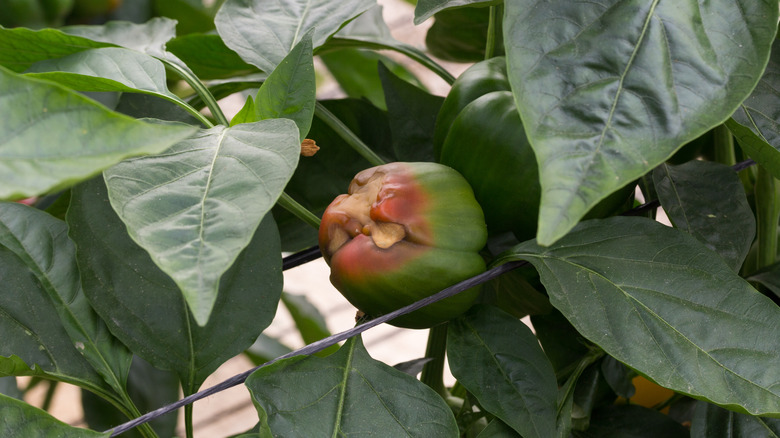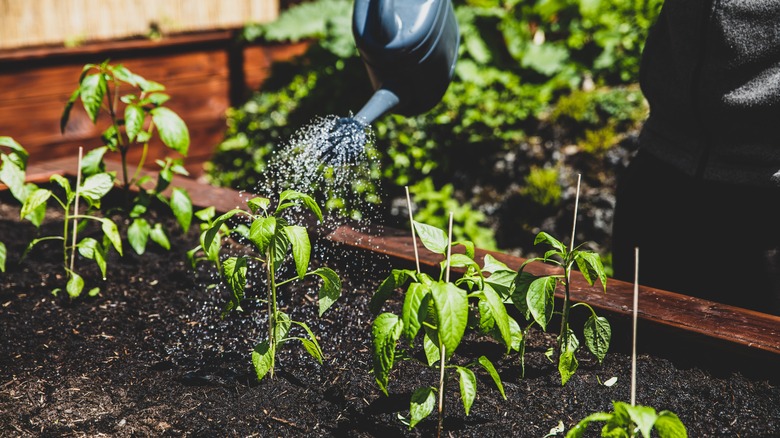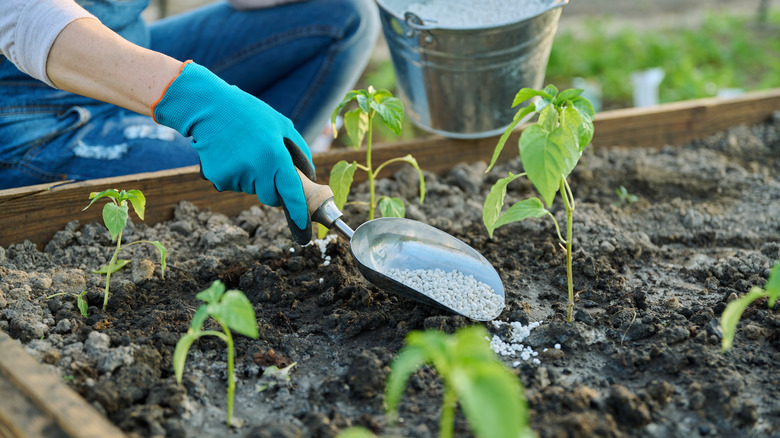Your Rotting Peppers May Indicate A Lack Of This Nutrient
Spring becomes especially charming when it's time to plant pepper seedlings (Capsicum annuum). But the charm wanes when the plant develops and the young fruit appears damaged and decayed. If the crown fruits (first fruiting round) develop sunken water-filled bruises at their blossom end (the part opposite the stem), chances are your peppers are deficient in calcium. In under two weeks, the problem — blossom end rot — can spread to almost half the fruit and cause brownish-black rubbery lesions or pits. Worse, such fruits become breeding grounds for fungal and bacterial infections. Rarely, the rot disease may not exhibit any signs on the outside and become apparent only when the cut fruit reveals discolored insides. Don't misdiagnose it as sun scald – blossom end rot appears brown uniformly across the fruit's distal end or lower walls, regardless of light exposure, unlike the former's pale patches seen only on sun-exposed sidewalls.
An architectural mainstay (think limestone!), calcium plays a similar building and stabilizing role in plants. During the fruit production stage, it supports the development of strong cell membranes, and a deficiency causes the growing fruits to cave in and decompose. Calcium also stimulates new root growth. So, before growing peppers, treat the substrate with lime or gypsum if a soil test (like Mehlich-1) confirms a lower calcium concentration. Eggshells and bonemeal work if the pH hovers between 6 and 6.8. But if the soil is fine, you're likely underwatering or overfertilizing your pepper plants.
Poor watering practices impair calcium uptake
Pepper plants don't absorb calcium directly from the soil. Instead, they rely on the transpiration-driven xylem's water movement to absorb calcium. Since new foliage and stems have larger surface areas than fruits, they transpire more, monopolizing water movement and calcium uptake. This wouldn't be a problem if the plants were watered on time. However, if they are under-irrigated and experiencing drought stress, the developing fruits wouldn't receive sufficient calcium to build robust cell walls. Since the fruit's terminal ends are the last to receive water, blossom root rot begins there and spreads, primarily affecting longer fruits. Moreover, as the fruits ripen and grow ball-sized, they develop water-impermeable waxy coatings that don't transpire much, which limits their calcium access.
While watering 1 inch weekly is commonly advocated, you might have to water more, depending on temperature and humidity. An easy way to determine water needs involves rolling the soil (extracted from the garden bed) into a ball when the plant is expected to develop fruits. If the ball disintegrates, water your peppers. Ensure the soil isn't compacted, drains poorly, or is infested with pathogens (especially nematodes), as it mars the roots' ability to draw water. If necessary, spread a 3- to 4-inch-thick mulch layer at the plant's base to promote water retention. Avoid dark-shaded plastic mulch because it can raise the soil temperature and restrict root extension. Be careful during cultivation so you don't harm feeder roots, which would reduce their nutrient intake capacities.
Overfertilization can ruin your peppers
Calibrating fertilization levels to the plant's growth is key to preventing peppers from rotting prematurely. Soil contains several nutrients, including calcium, magnesium, potassium, and ammonium-nitrogen, essential for plant intake. However, an overapplication of nitrogen or potassium tips the scales in favor of higher foliage growth. Since water will prioritize new leaves, this will decrease the calcium available to fruits and leave them to rot. Another pitfall of overusing fertilizers is it intensifies your garden's soil content, creating unfavorable conditions that reverse the water movement from the roots to the soil and inhibit water absorption.
Look for excessive shoot growth at the top to identify overfertilization. On confirmation, swap out nitrogen sources for calcium-based fertilizers, such as calcium nitrate or calcium thiosulfate. Inject them through drip irrigation systems so the roots can directly uptake calcium and move it through the plant to reach developing fruits. Stop when the fruits' sizes match a golf ball. Avoid foliar applications as the fruits are unlikely to absorb calcium, except when the fruit is young and has not yet developed the waxy covering. In such cases, broadcast about 2 to 4 pounds of calcium per acre, although this method won't be as effective as drip application. Going forward, stick to nitrogen in nitrate forms instead of applying ammonium because it restricts calcium's passage.


